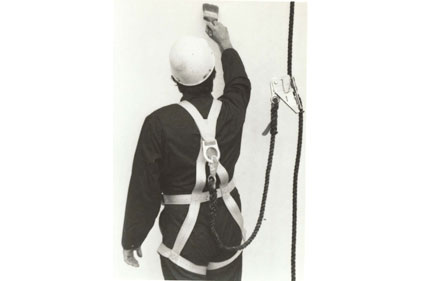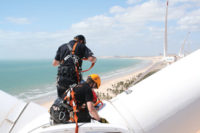In the early 20th century, the body belt — worn loosely around the waists of utility linemen during pole climbing — was the first form of fall protection to emerge. Soon, the drawbacks — and dangers — of using the body belt as a fall arrest device became apparent — dangerous fall arrest forces are transmitted directly to a worker’s spine and midsection. In order for the belt to successfully arrest a fall, the worker had to fall “correctly,” which still left the victim suspended horizontally. Worst case scenario, if a worker fell “incorrectly,” the belt could be pulled up to the worker’s armpits, or worse, the worker could even slip out of the belt completely.
By the 1940s, manufacturers worked on better distribution of fall arrest forces throughout the body and on reducing the chances that a worker could slip out of the fall protection system. Inspired by the military parachute harness used by paratroopers, the first harness was a vast improvement from the body belt, but heavy, bulky materials made the first full-body harness challenging to use and uncomfortable to wear.
The harness evolves
End-user feedback, along with the growing industry need for a harness that was less difficult to use, helped modernize the harness. Manufacturers developed triangular and X-fit style harnesses — both of which were easier to use. Instead of having to untangle a mess of straps, users could easily put on the harness like a backpack, grasping it by the dorsal D-ring feature.
In 2001, with input from ergonomics experts, industrial designers, and mechanical engineers, the first premium comfort harness was modeled after recreational harnesses. It married features like padding and soft edging with durable materials, yet was still almost as light and comfortable as a piece of work clothing.
Meeting today’s needs
Today’s generation of harnesses address all the key needs of the worker: comfort, ease of use, and durability. Features such as locking quick-connect buckles and innovative torso adjusters help eliminate the need to make adjustments during the day. State-of-the-art breathable mesh padding and lightweight aluminum components ensure worker comfort. Strategic use of fabrics and plastics in wear areas, plus moisture- and abrasion-resistant webbing help to increase the life of the harness and the overall satisfaction of the user.
Finding the ideal harness
Today’s harnesses are more worker-friendly and longer lasting than ever. Still, there are a few key features that set some models apart from the competition, helping to maximize workers’ safety and comfort on the job without sacrificing productivity. When it comes to harness selection, here’s what you should be paying attention to:
Safety: The most important aspect of the evolution of the full-body harness is that it has become significantly safer every decade. Yet, it’s still critically important to ensure a harness meets all current applicable OSHA and ANSI standards before it is used. A vigorously tested, state of the art harness brings a peace-of-mind element to any jobsite where workers are exposed to fall hazards.
Comfort/specialty materials: Believe it or not, harnesses of the past were once constructed of cotton and leather. Today the predominant material is polyester, which strikes a balance between comfort and durability. Other materials, such as heavy-duty nylon and Nomex®/Kevlar® blends, are used when harnesses are exposed to high heat environments such as welding or arc flash hazards.
Specialty features: Industry-specific requirements have resulted in more specialized features to customize the harness for particular environments. Features such as seat slings, derrick belts, built-in safety vests, areas to attach tool pouches, PVC-coated hardware, pockets, and front, back, side and positioning D-rings have contributed to increased productivity and safety in different applications, including tower climbing, oil and gas, construction, utilities, wind energy and transportation.
In the construction industry, for example, consider that the harness will be worn for the duration of the workday. To make sure wearing one doesn’t become a chore, look for a model that offers strategically located padding, such as a belt and hip pads that provide additional back support, and tool carrying options.
As technology evolves in the fall protection industry so will the design of the full-body harness. Engineers, manufacturers and designers will continue to focus on enhancing harnesses to seamlessly integrate with a worker’s movements and everyday tasks as well as promote safety. When it’s time to invest in a new harness, remember that safety is your top priority and comfort a close second.





